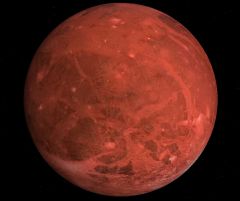28978 Ixion
Revision as of 13:20, 11 October 2024 by Arvil (talk | contribs) (Arvil moved page User:Arvil/Sandbox02 to 28978 Ixion: Move to article page.)
| 28978 Ixion | |
|---|---|

| |
| 28978 Ixion from Kuiper Objects Pack.zip in Orbiter 2006P1 | |
| Designation | |
| Name | 28978 Ixion |
| Reference body | Sun |
| Planetary mean orbits | |
| Epoch | 2005.71598173516 |
| Semimajor axis (a) | 5914965169039 m |
| Eccentricity (e) | 0.241252 |
| Inclination (i) | 19.6134° (0.342318407512224 radian) |
| Longitude of the ascending node (LAN, ☊) | 71.0268° (1.239651517843398 radian) |
| Longitude of periapsis (ϖ) | 110.499999998012° (1.92858882341904 radian) |
| Mean longitude (L) | 24.70671° (0.431213436835408 radian) |
| Selected physical parameters | |
| Mean radius | 880000 m |
| Mass | 2.773×1017 kg |
| Rotation elements | |
| SidRotPeriod | 86400 seconds (24 hours) |
| SidRotOffset | 0 |
| Obliqutiy | 0.535467015 |
| LAN | 0 |
| Note | *Elements given are from Ixion.cfg (Kuiper Objects Pack.zip) |
28978 Ixion (2001 KX76) is a large Kuiper Belt object and possibly a Dwarf planet and is also classified as a plutino, an object in a 3:2 resonance orbit with Neptune. It was discovered on 22 May 2001 by the Deep Ecliptic Survey at the Cerro Tololo Observatory in Chile.
28978 Ixion in Orbiter
28978 Ixion is modeled as an 800 km body. It was introduced to Orbiter with the release of the add-on Kuiper Objects Pack.zip in August 2006.
| Add-on | Source | Version | Author | Type | Release Date | Compatibility | Wiki article |
|---|---|---|---|---|---|---|---|
| Kuiper Objects Pack | O-F Resources | 2006-08-10 | markl316 | Scenery | 11 August 2006 | ||
See also
Gallery
Ixion imaged by the HST in February 2006
from Wikimedia CommonsIxion imaged by the Wide Field Imager at the La Silla Observatory in Chile in 2001
from Wikimedia Commons
| edit The Solar System | |
|---|---|
| Central star |
Sun (Sol) |
| Planets |
Mercury - Venus - Earth - Mars - Jupiter - Saturn - Uranus - Neptune |
| Natural satellites |
Moon - Phobos - Deimos - Io - Europa - Ganymede - Titan - more... |
| Add-ons |
Planets - Dwarf Planets - Small objects - Natural satellites - Alternative star systems |


